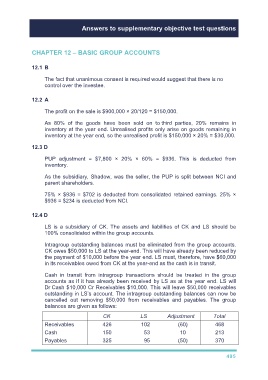Page 503 - Microsoft Word - 00 CIMA F1 Prelims STUDENT 2018.docx
P. 503
Answers to supplementary objective test questions
CHAPTER 12 – BASIC GROUP ACCOUNTS
12.1 B
The fact that unanimous consent is required would suggest that there is no
control over the investee.
12.2 A
The profit on the sale is $900,000 × 20/120 = $150,000.
As 80% of the goods have been sold on to third parties, 20% remains in
inventory at the year end. Unrealised profits only arise on goods remaining in
inventory at the year end, so the unrealised profit is $150,000 × 20% = $30,000.
12.3 D
PUP adjustment = $7,800 × 20% × 60% = $936. This is deducted from
inventory.
As the subsidiary, Shadow, was the seller, the PUP is split between NCI and
parent shareholders.
75% × $936 = $702 is deducted from consolidated retained earnings. 25% ×
$936 = $234 is deducted from NCI.
12.4 D
LS is a subsidiary of CK. The assets and liabilities of CK and LS should be
100% consolidated within the group accounts.
Intragroup outstanding balances must be eliminated from the group accounts.
CK owes $50,000 to LS at the year-end. This will have already been reduced by
the payment of $10,000 before the year end. LS must, therefore, have $60,000
in its receivables owed from CK at the year-end as the cash is in transit.
Cash in transit from intragroup transactions should be treated in the group
accounts as if it has already been received by LS as at the year end. LS will
Dr Cash $10,000 Cr Receivables $10,000. This will leave $50,000 receivables
outstanding in LS’s account. The intragroup outstanding balances can now be
cancelled out removing $50,000 from receivables and payables. The group
balances are given as follows:
CK LS Adjustment Total
Receivables 426 102 (60) 468
Cash 150 53 10 213
Payables 325 95 (50) 370
495

